Body Clock Profile EMS User manual

Profile EMS
Instructions for use
Profile EMS Instructions 18/5/06 10:19 Page 1

Before you use your Body
Clock Profile EMS, it is
important that you read
this manual carefully.
It contains all the
information you need to
ensure you are using the
unit safely and correctly.
Explanation of Symbols on Unit
Equipment providing a particular
degree of protection against electric
shock particularly regarding allowable
leakage currents having an F type
(floating) applied part.
Warning – refer to accompanying
documents i.e. these instructions.
Denotes a product which must be
disposed of safely.
1
Profile EMS Instructions 18/5/06 10:19 Page 2

Contents
About EMS ....................................................3
What can EMS be used for? ..........................3
The Profile EMS controls............................4/5
Display symbols and their meanings ............6
Additional features of the Profile EMS ..........7
Setting up your Profile EMS ..........................8
Instruction for use ........................................9
Operation Modes:
- Constant....................................................10
- Cycle ..........................................................11
- Reciprocal and Contraction........................12
- Contraction Reciprocal and
Contraction Rest ........................................13
- Relaxation ................................................14
Device Failures ............................................14
Maintenance and Care ................................15
General Precautions ....................................15
Checking System Performance ....................15
Contraindications and Precautions..............16
Technical Data ........................................17/18
2
Profile EMS Instructions 18/5/06 10:19 Page 3

About EMS
EMS stands for Electronic Muscle Stimulation.
This treatment consists of delivering
electrical impulses through the skin into the
nerve fibres and muscles that lie beneath.
Skin contact is made via surface electrodes
placed on the body. The EMS unit will then
stimulate the muscles to contract and relax.
NOTE
Before using EMS, if you have any questions
about a particular condition or if problems
arise, please seek advice from your physician
or therapist.
What can be EMS be used for?
Toning and strengthening all muscle groups
for athletic training, bodybuilding and sports
injuries, after pregnancy, weight loss, cosmetic
purposes, chronic back pain and incontinence.
EMS can also be used to tone specific muscle
groups after immobilisation of fractures and
soft tissue injuries.
3
Profile EMS Instructions 18/5/06 10:19 Page 4

The Profile EMS Controls
Intensity control for CH.1
User
Display
Jackplug/
leadwire
On/off
button
Timer
Mode
Selector
Time Key Frequency Key
Intensity control for CH.2
4
Profile EMS Instructions 18/5/06 10:19 Page 5

Controls and Display Symbols.
Controls and Display Symbols.
CH1 INTENSITY key – press the ‘CH1
INTENSITY’ key, (up arrow) to increase or
(down arrow) to decrease the intensity.
CH2 INTENSITY key – press the ‘CH2
INTENSITY’ key (up arrow) to increase or
(down arrow) to decrease the intensity.
USER DISPLAY This is the LCD display
which keeps you informed about the
modes and settings you are using.
JACK PLUG sockets. This is where the
leadwires are connected to the unit.
ON/OFF key – press the ‘ON/OFF’ key to
turn the unit on and off. The output
intensity in both channels starts at zero
when the unit is switched on.
FREQUENCY key – press the ‘FREQ’ key to
increase or decrease the frequency,
otherwise known as pulse rate (up arrow)
to increase or (down arrow) to decrease
frequency.
TIMER button, enables the Profile EMS
to switch off automatically, if required. To
adjust the time you wish your treatment
to last, press either the up arrow or down
arrow on the Time key. Once you have
the correct time, press the Timer key
again to confirm.
MODE – press the ‘MODE’ key to change
the operating mode. After changing
mode the intensity will automatically drop
to zero to ensure comfort and safety.
TIME key – press the ‘TIME’ (+) and (-)
keys after pressing the ‘TIMER’ key to
select the desired setting. See 7 above.
5
Profile EMS Instructions 18/5/06 10:19 Page 6

Display Symbols and their Meaning
Channel 2
intensity indicator
Channel 1
intensity indicator
Frequency indicator –
indicates the current
frequency (pulse rate)
Mode indicator -
indicates the mode in
use. Only one of these
seven modes will be
displayed at any one
time
Flashing electrode
icon indicates when
electrodes are not
attached to skin -
see page 7
Timer – indicates the timer
setting in minutes, or
displays ‘C’ to indicate the
unit will stay on until
switched off manually
Pulse width indicator –
indicates the current pulse
width (depending on mode)
Waveform indicator – indicates
the current waveform (depends
on mode)
6
Profile EMS Instructions 18/5/06 10:19 Page 7

Memory
When the unit is switched off it will remember
its previous settings. These will be restored
when the unit is next switched on.
Factory Default
The unit initially powers up in Constant Mode
and when the batteries are replaced.
Automatic Power Off
The unit will switch off automatically if the
intensity on both channels is at zero and the
unit has not been used for approximately
5 minutes.
Load Detector
When there is no contact between the device
and human skin, it is only possible to increase
the intensity output to level 2. Should this
happen, the flashing electrode icon will
appear on the LCD display.
Low Battery Detection
When the batteries fall below 2.2v 0.2v a
flashing battery icon will appear on the
display.
Additional features of the Profile EMS
7
Profile EMS Instructions 18/5/06 10:19 Page 8

Check the following contents: The Assembly Stage
a) The battery compartment is found on the
front of the unit and is marked by a
ribbed triangle. Open by gently pressing
on the ribbed section with the thumb.
b) Insert batteries, ensuring the positive (+)
and negative (-) terminals are in the
correct position as marked in the battery
compartment. Replace battery cover.
c) With the unit switched off, insert the
leadwire pin ends into the electrodes and
the Jack plug ends into sockets found on
the side of the unit. See diagram on
page 4.
Setting Up Your Profile EMS
1 x Profile EMS unit
1 x pack of self adhesive electrodes
2 x leadwires
4 x AA batteries
1 x An Easy Guide to EMS (UK only)
8
Profile EMS Instructions 18/5/06 10:19 Page 9

1. Turn on your Profile EMS by means of the
ON/OFF button. The unit starts in the
Constant Mode initially.
2. Choose the mode you wish to use by
pressing the mode button until the mode
you require shows on the LCD screen.
Details of the functions of each mode are
set out later in this booklet.
3. Slowly increase the intensity using the
intensity controls. See diagram on
page 4.
4. If you stimulate for a number of hours, it
is advisable to check that your electrodes
have not become too dry as this could
cause minor skin irritation. If this
happens, dampen them slightly.
5. When you have finished stimulating, turn
off the unit by means of the ON/OFF
button.
6. Ensure that the unit is switched off before
removing the leads. Do not pull the
leadwires. Remove leads by holding the
jack plugs between the forefinger and
thumb.
Instructions For Use
9
Profile EMS Instructions 18/5/06 10:19 Page 10

The ‘MODE’ key is used to select the
operating mode. As a safety feature, after any
mode change the intensity will drop to zero.
There are seven modes available on the Body
Clock Profile EMS and in all modes intensity is
adjustable by means the CH1 and CH2 keys.
• In Constant Mode there is continuous
output. Frequency can be adjusted
between 1 and 80Hz using the ‘FREQ’ key,
and intensity can be adjusted using the
‘CH1’ and ‘CH2’ keys.
• To automatically switch the unit off after 5
to 50 minutes (in 5 minute intervals), or
for the unit to remain on until switched
off manually (‘C’ setting), press the
'TIMER' button. Depending on the unit's
previous setting you will either see a
flashing time to the right of the clock icon
at the bottom of the LCD or a flashing 'C'.
By means of the 'TIME' key you can select
the required duration of treatment. If you
select 'C', treatment will continue until
you turn the unit off manually. To confirm
your selection, press the 'TIMER' button
again and the number (or 'C') will stop
flashing.
• Please note that it is not possible to
adjust the intensity while you are setting
the timer, i.e. while the time (or 'C') is
flashing.
The Operation Modes -
10
Constant Mode
Profile EMS Instructions 18/5/06 10:19 Page 11

• In Cycle Mode, both channels are on and
off in regular cycles.
• Frequency can be adjusted between 1 and
80Hz using the ‘FREQ’ key, and intensity
can be adjusted using the ‘CH1’ and ‘CH2’
keys.
• The 'TIMER' button and the 'TIME' key
are operated as follows:-
• Press the ‘TIMER’ button and the on time
will be displayed with the number of
seconds flashing. Adjust the on time
using the ‘TIME’ key.
• Press the ‘TIMER’ button to confirm your
selection and the off time will now be
displayed, again with the number of
seconds flashing. Adjust the off time
using the TIME key. Confirm your
selection using the ‘TIMER’ button.
• You can now use the ‘TIME’ key to set the
timer to automatically switch the unit off
after 5 to 40 minutes (in 5 minute
intervals), or to stay on until switched off
manually (‘C’ setting) in exactly the same
way as for the Constant Mode described
on page 10.
Cycle Mode
11
Profile EMS Instructions 18/5/06 10:19 Page 12

• This mode is similar to the Cycle Mode
(described on previous page).
• The difference is that in Reciprocal Mode
the two channels are switched on and off
alternately (i.e. when Channel 1 is on,
Channel 2 if off and vice-versa).
The TIMER and TIME functions operate in
exactly the same way as for the Cycle
Mode.
• The Contraction Mode makes muscles
gradually contract and relax.
• To set the length of the contractions press
the ‘TIMER’ button. The ON time will flash.
• Set the ON time using the ‘TIME’ key and
confirm your selection by pressing the
‘TIMER’ button. There is no OFF time in
the contraction mode.
• You can now use the 'TIME' key to set the
timer to turn the unit off automatically, in
the same way as for the Cycle Mode
(see page 11).
Reciprocal Mode Contraction Mode
12
Profile EMS Instructions 18/5/06 10:19 Page 13

• This mode is similar to the Contraction
Mode (page 12). The only difference is that
in Contraction Reciprocal mode the two
channels are on and off alternately (i.e.
when Channel 1 is on, Channel 2 if off and
vice-versa).
• This mode is also similar to the Contraction
Mode (page 12). The difference is that in this
mode, there is a rest period after each
contraction.
• To set the length of the contractions press
the ‘TIMER’ button. The ON time will now be
flashing.
• Set the on time using the ‘TIME’ key and
confirm your selection by pressing the
‘TIMER’ button.
• The flashing rest time option is now set
using the ‘TIME’ key, and confirmed using
the ‘TIMER’ button.
• You can now set the timer to switch the unit
off automatically, or set it to ‘C’ so that it
remains on until manually switched off as
before.
13
Contraction Reciprocal Mode Contraction Rest Mode
Profile EMS Instructions 18/5/06 10:19 Page 14

14
• Use this mode to relax muscles.
• The frequency can be adjusted using the
‘FREQ’ key.
• Both channels are permanently on in this
mode, so there are no ON or OFF times to
set.
• The timer can be set to turn the unit off
automatically, or set to remain on until
switched off manually, as above.
Device Failures
• Please do not attempt to repair damaged
devices yourself.
• In case of further enquiries, always state
the model of your device: i.e. ‘Profile
EMS.’
• Body Clock Profile EMS units should be
repaired by qualified technical personnel.
• Body Clock Profile EMS units are
guaranteed for a period of 5 years against
manufacturer’s defects excluding
(leadwires and electrodes).
Note: the guarantee is null and void if any
attempt is made to open the unit by
unauthorised personnel.
• In the event of a fault please contact the
supplier (address found on the invoice or
delivery note)
or
Body Clock Health Care,
108 George Lane,
South Woodford E18 1AD.
Tel: (+44) (0) 20 8532 9595
Fax: (+44) (0) 20 8532 9551
email: [email protected].
Relaxation Mode
Profile EMS Instructions 18/5/06 10:19 Page 15

15
Maintenance and Care
• Change the batteries regularly.
• The unit must be switched off when
changing the batteries.
• The unit and lead wires may be wiped
clean by using a very slightly dampened
cloth. Mild soap may be used but DO
NOT apply solvents.
• Never immerse the stimulator in water.
General Precautions
• Do not yank or twist the leadwires. Treat
them gently for long life. They are made
from fine wire to be flexible and
lightweight.
• Do not place your Body Clock Profile EMS
close to any source of excess heat.
• Do not operate your unit in the presence
of flammable gases.
• Do not attempt to open the Body Clock
Profile EMS unit.
• Do not use battery or power sources
other than those specified.
• Do not drop this unit onto a hard surface.
Checking System Performance
• If your unit does not appear to be
operating properly, try changing the
battery. Replacing the battery can
eliminate most problems.
• Check that the leadwires are properly
connected to the unit.
• Check the electrodes are firmly attached
to the leadwire pins.
• Make sure that the leadwires are not
damaged or broken.
Profile EMS Instructions 18/5/06 10:19 Page 16

16
• Powered muscle stimulators should not
be used by patients with demand type
cardiac pacemakers.
• Powered muscle stimulators should not
be used during pregnancy.
• Powered muscle stimulators should not
be used until 12 weeks after childbirth.
• Do not use this unit while operating
machinery or while driving.
• Stimulation should not be applied over
the carotid nerves, the neck or mouth,
transthoracically or transcerebrally.
• Stimulation should not be applied over
swollen, infected or inflamed areas of
skin or over or in proximity to cancerous
lesions.
• Caution should be used for patients with
suspected or diagnosed heart problems,
or epilepsy.
• Caution should be used where there is a
tendency to haemorrhage following acute
trauma or fracture, following recent
surgical procedures when muscle
contraction could disrupt the healing
process, over the menstruating uterus,
over areas of skin which lack normal
sensation.
• Some patients may experience mild skin
irritation due at the site of the electrodes.
This can sometimes be reduced by using
alternative electrodes and/or
repositioning them.
• Electrode placement and stimulation
settings should be based on the guidance
of the prescribing practitioner.
Contraindications and Precautions
Profile EMS Instructions 18/5/06 10:19 Page 17

17
Modes
• 8 seven segment digits and around 97 segments
• Seven modes
Constant
Waveform: Symmetrical Biphasic
Frequency changes between 1 and 80Hz
Fixed pulse width 300us
Cycle
Waveform: Symmetrical Biphasic
Frequency changes between 1 and 80Hz
Fixed pulse width 300us
Reciprocal
Waveform: Symmetrical Biphasic
Frequency changes between 1 and 80Hz
Fixed pulse width 300us
When Channel 1 is on, Channel 2 is off, or Reverse
Contraction
Waveform: Symmetrical Biphasic
Pulse widths increase from 40us to 400us then
starts again from 40us, Frequency increases from
80Hz to 120Hz the start again from 80Hz within the
preset time period.
Contraction Reciprocal
Waveform: Symmetrical Biphasic
Pulse width increases from 40us to 400us then
starts again from 40us, Frequencies increase from
80Hz to 120Hz then start again from 80Hz within the
preset time period. When Channel 1 is on, Channel 2
is off, or Reverse
Contraction +Rest
Waveform: Symmetrical Biphasic
Pulse widths increase from 40us to 400us then
starts again from 40us, Frequency increases from
80Hz to 120Hz then starts again from 80Hz within
the preset time period.
Relaxation
Waveform: Monophasic Bipolar
Frequency changes between 1 and 10Hz
Fixed pulse width 50us
Technical Data
Profile EMS Instructions 18/5/06 10:19 Page 18

18
Pulse Frequency (Hz) Pulse Width (£gs) Max pk-pk output
CONSTANT 1 – 80 300 95V
CYCLE 1 – 80 300 95V
RECIPROCAL 1 – 80 300 95V
CONTRACT 80 – 120 40 – 400 95V(at 400us) / 140V(at 10us)
CONTRACT RECIP 80 – 120 40 – 400 95V(at 400us) / 140V(at 10us)
CONTRACT REST 80 – 120 40 – 400 95V(at 400us) / 140V(at 10us)
RELAX 1 – 10 50 135V
28 selectable frequencies:
1, 2, 3, 4, 5, 10, 15, 20, 25, 30, 35, 40, 45, 50,
55, 60, 65, 70, 75, 80, 85, 90, 95, 100, 105, 110, 115, 120
Timer Count down timer has 11 selectable settings
Continuous, 5, 10, 15, 20, 25, 30, 35, 40, 45, 50minutes
Automatic Power Off 5 Minutes
Output Channel Dual Channel
Output Voltage 0 – 95V in max pulse width with 20 adjustable steps (500£[ load, peak to peak)
Output Intensity 0 – 190mA in max pulse width with 20 adjustable steps (500£[ load, peak to peak)
Intensity level drops back to 0 after mode changes
Output Waveform Symmetrical Biphasic and Monophasic Bipolar
Output Jacks CE Touch-proof jacks
Load Detector Contact detection between the device and human skin
Battery 2 ° - 1.5V AA Battery (Type LR6)
Battery Low Detect 2.2V°”0.2V
Profile EMS Instructions 18/5/06 10:19 Page 19

Body Clock Health Care Ltd
108 George Lane,
South Woodford,
London
E18 1AD
Tel (+44) (0)20 8532 9595
Fax (+44) (0)20 8532 9551
www.bodyclock.co.uk
0120
May 2006 (1)
ISO 9001: 2000 ISO 13485:2003
EC DIRECTIVE 93/42/EEC Annex V
Profile EMS Instructions 18/5/06 10:19 Page 20
Table of contents
Other Body Clock Medical Equipment manuals
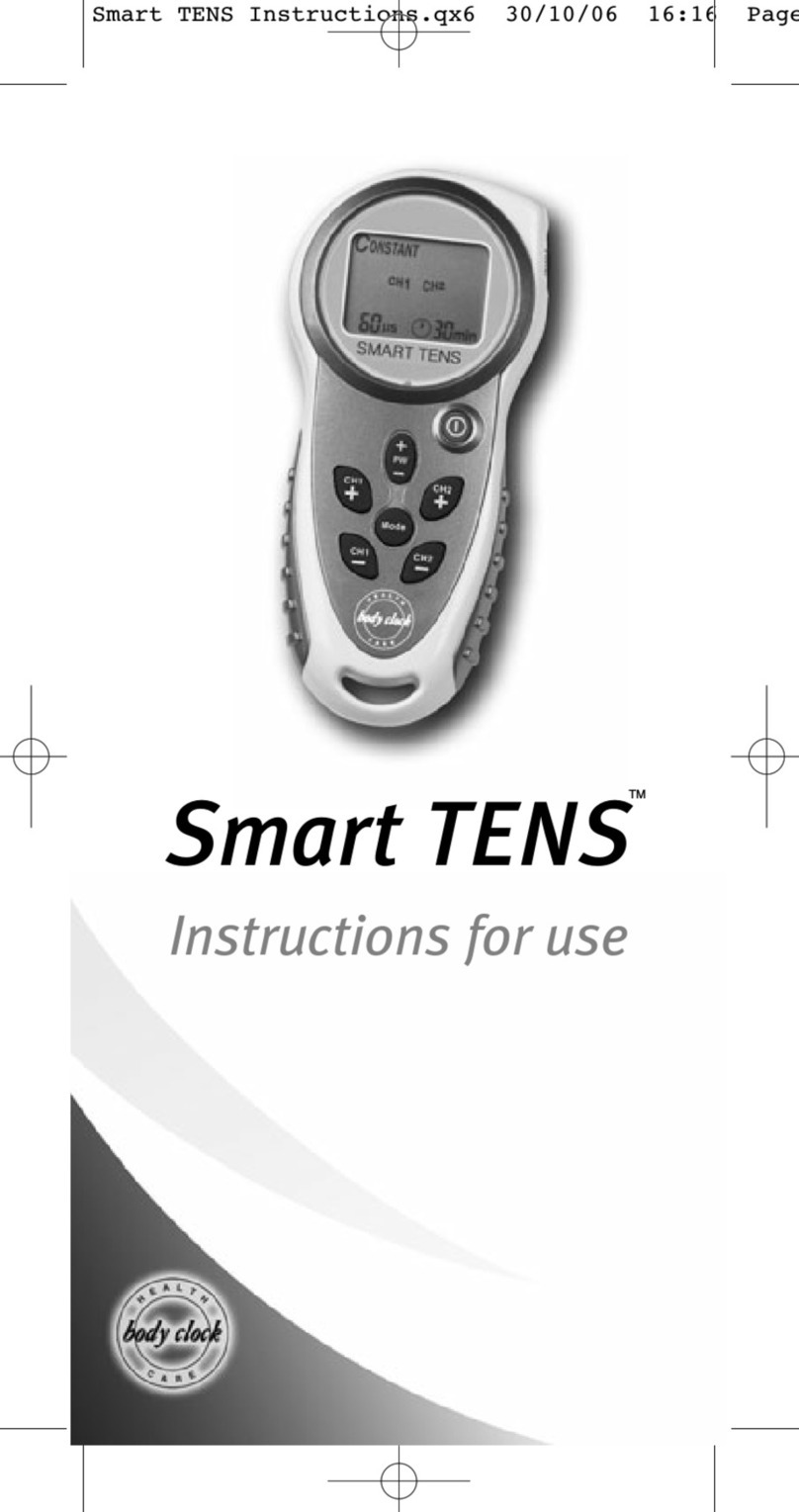
Body Clock
Body Clock Smart TENS User manual
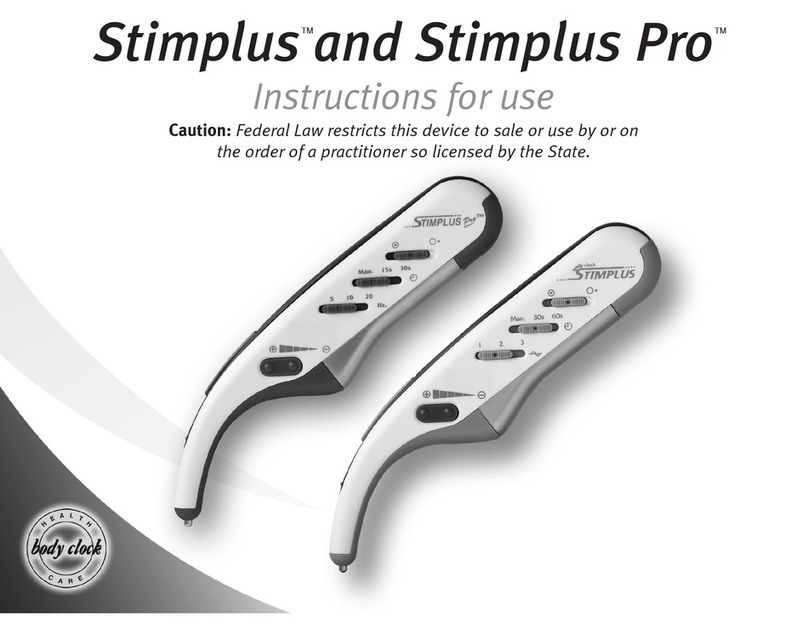
Body Clock
Body Clock Stimplus User manual
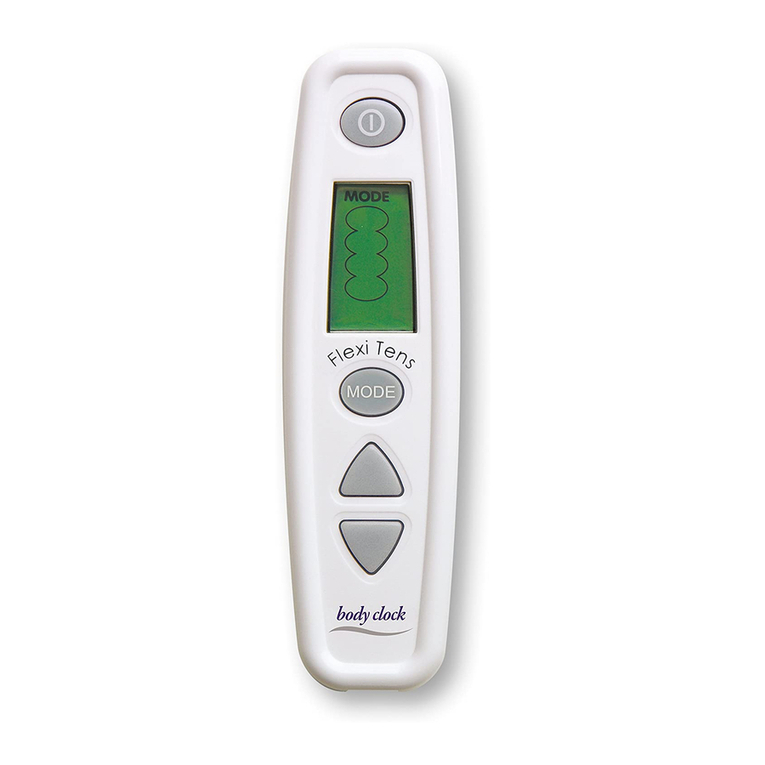
Body Clock
Body Clock Flexi TENS User manual
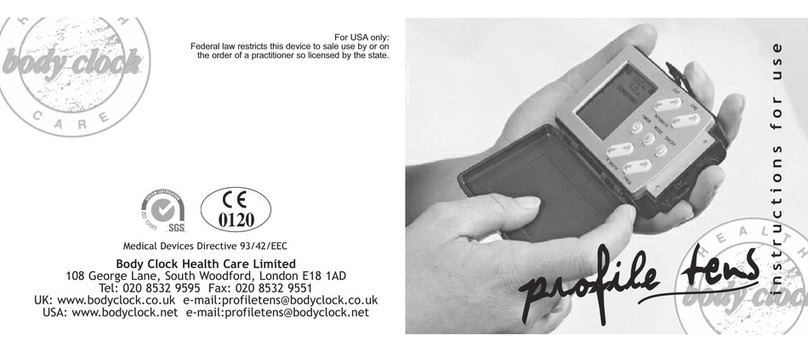
Body Clock
Body Clock Profile TENS User manual
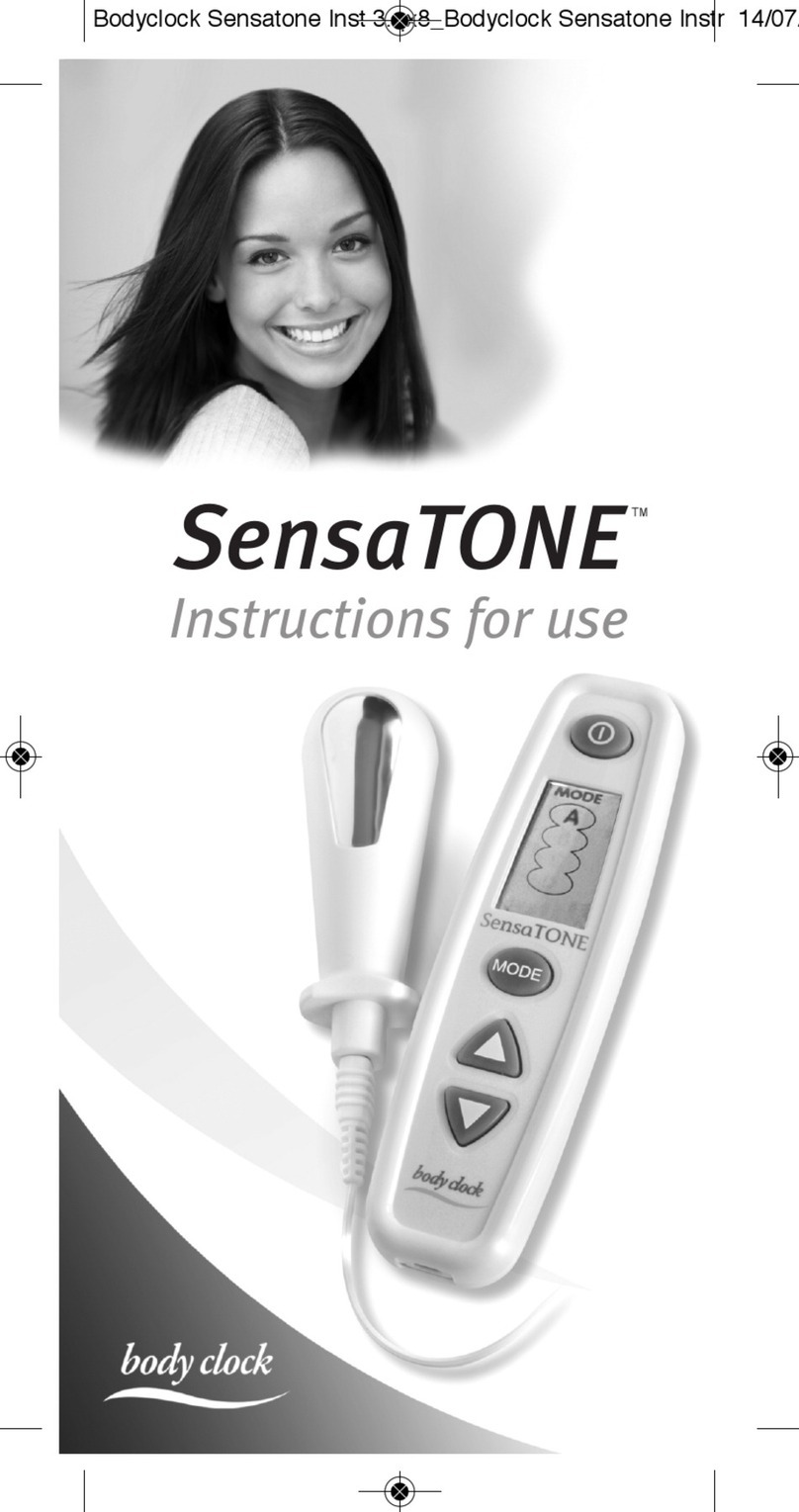
Body Clock
Body Clock SensaTONE User manual

Body Clock
Body Clock Profile TENS User manual
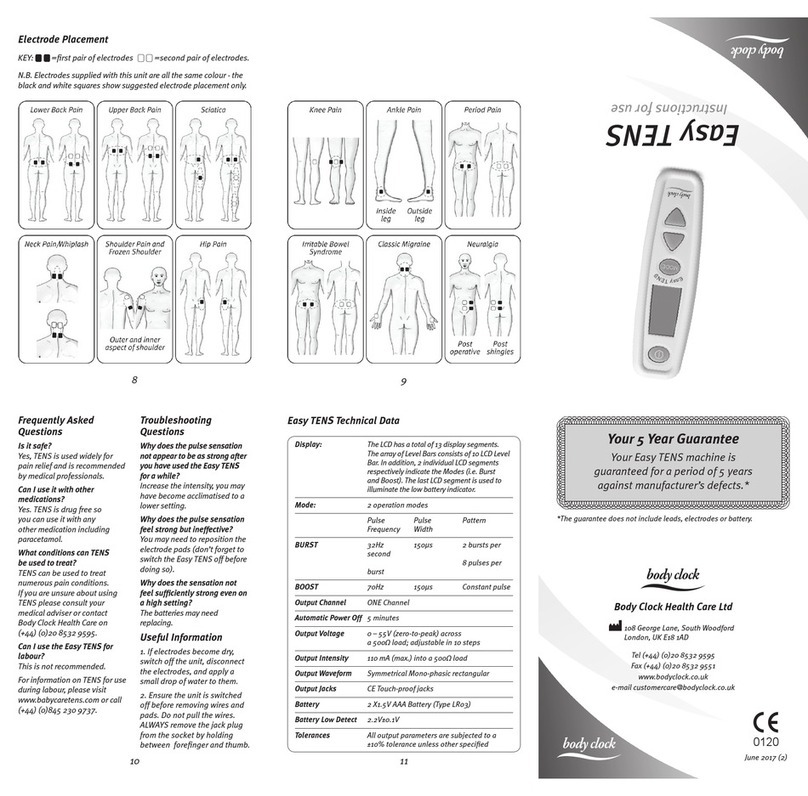
Body Clock
Body Clock Easy TENS User manual

Body Clock
Body Clock Easy TENS User manual
Popular Medical Equipment manuals by other brands

Getinge
Getinge Arjohuntleigh Nimbus 3 Professional Instructions for use

Mettler Electronics
Mettler Electronics Sonicator 730 Maintenance manual

Pressalit Care
Pressalit Care R1100 Mounting instruction

Denas MS
Denas MS DENAS-T operating manual

bort medical
bort medical ActiveColor quick guide

AccuVein
AccuVein AV400 user manual











